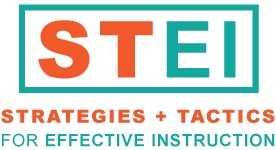Back to: Delivering
Regardless of time spent planning, instructional presentations sometimes need to be modified to meet the individual learning needs of students. Effective teachers use a variety of tactics when adjusting their instruction.
use classroom space effectively
Seat students who learn better visually so they can easily see the instructional presentation. Use examples and actual demonstrations with these students; sometimes have them act out or demonstrate what is being taught (and learned). Use charts, maps, graphs, and tables as often as possible. Seat students who learn better auditorily so they can easily hear the instructional presentation. Keep directions simple for these students and have them repeat.
provide alternatives for evaluation
Some students perform better in one-on-one or small group settings than in a single large classroom group. Providing opportunities for different testing arrangements, including open book, student-designed tests or open notes assessments, fosters student learning and illustrates an easy way to adapt instruction to meet individual needs.
use organizers and study guides
Many students do not need assistance taking notes and focusing on appropriate learning content during lessons. Others profit greatly from instructional adaptations designed to support presentations. Provide study guides, learning outlines, alternative presentations (e.g., tape recorded lectures) and self-monitoring cue cards as adaptations to accommodate these individual differences.
